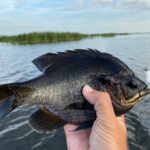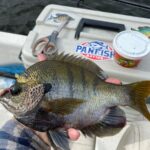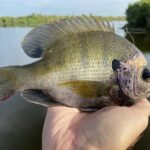We’ve all heard of black crappie and white crappie…but what about a black nose crappie?
What exactly are they? Where are they found? Let’s dig into this fascinating and rare fish topic!
Table of Contents
What is a Black Nose Crappie?
Crappies are divided into two subspecies- the white and black crappies. Today I am going to tell you about an unusual and distant cousin of the black crappie, known as the black nose crappie.
Black nose crappie have an unusual appearance due to a recessive hereditary trait that gives them a thick black line from the dorsal fin down the nose. Other than the appearance, they are the same exact species as black crappie (Pomoxis nigromaculatus).
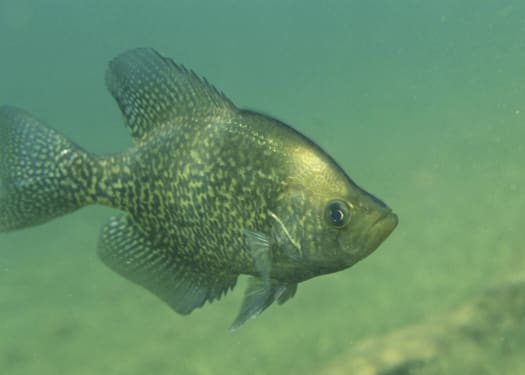
Black-nosed crappie were first discovered in Beaver Lake in northern Arkansas in 1984. Because of this, they were originally named the “Arkansas black nose crappie.”
They are now estimated to inhabit around 14 states in the USA!
Why are they different?
These crappie, also called black striped crappie, are notable for the black stripe running down their backs, all the way from the top of the dorsal fin, down the nose and onto the top lip.
These fish seem to like shallower waters than their cousins, especially in the summer months, perhaps making them a good target for people fishing from the bank.
Other than their appearance and some reported behavior, they are no different than black crappie.
Black nose crappie range
Although crappie were originally discovered in Arkansas, they have now become popular as far away as southern California.
Among the places where black nosed crappie have been caught are Kansas; eastern Texas; eastern Oklahoma; Florida; Illinois; Table Rock Lake in Missouri; Kentucky, Watts Bar, Center Lake and Reelfoot Lakes in Tennessee, Kentucky.
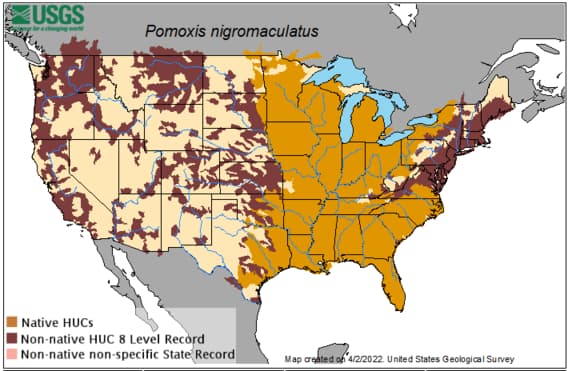
Several states are reported to stock these fish, including Arkansas, Kentucky, Tennessee, California, and Arizona. Mississippi’s state-operated lakes all are stocked with the black-nosed crappie, among other fish species.
Do Black Nose Crappie Reproduce?
Black nose crappie will breed true in nature. They are not sterile as some specially-developed hybrid crappie are.
Black nose crappie are also used in some hybrid combinations, notably a black nose male with a white crappie female.
The black stripe that carries over may be a little less dark in a hybrid than in a black nose crappie in some, but it greatly helps scientists count the crappie they are looking for when developing and tracking hybrids.
Can I stock my pond with Black Nose Crappie?
You can stock your pond with them if you have the proper habitat.
Some states have fish farms that offer them to private ponds and small lake owners, even if the state doesn’t stock them in its waterways. Some of the larger fish farms will ship crappie to other states.
Since black nose crappie do reproduce naturally, the possibility of overpopulation should be taken into consideration. You may want to discuss the matter with your fish supplier.
Don’t make the mistake of just coming back from a fishing trip and putting some extra adults into your pond and waiting for results.
Crappie are prolific spawners and can quickly overtake a pond or lake and stunt the population.
See Also: 5 Reasons Why Your Pond Smells Fishy
Frequently Asked Questions
What is a Magnolia Crappie?
The Magnolia Crappie was developed as a joint project by the University of Mississippi and the Mississippi Department of Wildlife, Fisheries, and Parks.
They attempted to create a sterile crappie hybrid, that would not overpopulate small enclosures making them ideal for smaller ponds and other habitats.
The magnolia crappie is cross between a male black-nosed crappie and a female white crappie. They retain the black dorsal stripe, making it easy for their populations to be monitored.
They tend to grow larger than crappie would ordinarily in the same environment, perhaps because they put the energy they would have expended in reproduction to use in growth.
Crappie have two sets of chromosomes naturally. These fish, in what’s known as the diploid condition, reproduce normally.
Breeders of certain hybrid species, such as the Magnolia crappie, remove the eggs from the chosen white crappie females, then fertilize them with sperm from black nosed crappie.
Exactly five minutes later, these eggs are put into a pressure chamber which exposes them to 8,000 psi of pressure for two minutes.
The eggs hatch normally, but they have an extra set of chromosomes because of the pressure treatment. This puts them into what’s known as a triploid condition.
The fry hatch and grow normally, and they do mate and lay eggs like any other fish, but the eggs will not hatch.
You May Also Like: Hybrid Bluegill vs Regular Bluegill…What’s The Difference?
Is there really a Golden Crappie?
There really is such a fish as a golden crappie, but it is extremely rare.
Golden crappies, otherwise known as a “xanthic” crappie have a genetic mutation that results in over-expression of the yellow and orange pigments in their skin.
In fact, if you search the internet, you’ll usually find several copies of the same picture posted. A local television station reported on the catch of one on Clear Lake, Minnesota, caught by a man ice fishing.
What Is The Black Nose Crappie Record?
There is no official record for the largest black-nose crappie ever caught since it is theoretically the same species as the black crappie.
Lionel Ferguson’s 5-pound, 7-ounce black crappie is the IGFA All-Tackle world record holder. It was caught on May 15, 2018 in Richeison Pond, in Loudon County.
How Rare Is A Black Nose Crappie?
This question depends on where you are fishing! Although this species is rare, they can still be found in 14 states in the US!
Where Can I Buy Black Nose Crappie For Sale?
J.M. Malone and Son, Inc.
The Hybrid Crappie produced by J.M. Malone and Son, Inc. is the original cross between an Arkansas Black Nosed Black Crappie male and a white crappie female resulting in a hybrid crappie with a black stripe running down its nose.
This black stripe is not an indication that a crappie is a hybrid crappie. Therefore, be advised when purchasing hybrid crappie, just because it has a black stripe on its nose does not make it a hybrid crappie.
You May Also Like: Can Largemouth and Smallmouth Bass Breed?
If you haven’t guessed yet, I love fishing and everything about it!
To learn more about why I started Panfish Nation, visit the About page and follow along on Social Media:


Download a copy of my FREE Lure Color Selection Chart & Knot Guide!
Stay up to date with fishing reports, tackle reviews, industry news, and much more! We respect your privacy, unsubscribe at any time.
Related Posts
- Crazy Facts About the World Record Crappie
- What Size Hooks for Smallmouth Bass? Quick Guide
- Large and in Charge-Mouth: 10 of the Best Bass Lures of All Time (And Where to Buy Them)
- Emperor of the Sun(fish): What You Need to Know About the World Record Bluegill
- Coppernose Bluegills: How They’re Different from Common Bluegill
- Bluegill vs Brim: Differences & Terminology, Explained!




